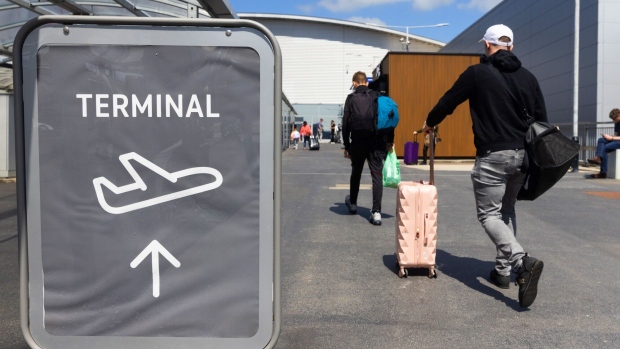Aug 28, 2023
UK Flights Snarled on Bank Holiday After Air-Traffic Failure
, Bloomberg News

(Bloomberg) -- Air-traffic control services in the UK sought to restore normal operations after an hours-long system outage led to hundreds of delays and cancellations on one of the busiest days this travel season.
The NATS authority said it had “identified and remedied” the technical issue that knocked out the automated flight planning system earlier on Monday.
The system failure prevented planners from automatically processing flight plans and forced them instead to revert to manual input, meaning they couldn’t manage the same volumes. Heathrow and Gatwick airports both experienced steep delays and cancellations, with chaotic scenes playing out at London’s two main hubs as the number of axed flights swelled.
“We are now working closely with airlines and airports to manage the flights affected as efficiently as possible,” NATS said in a statement. “Our engineers will be carefully monitoring the system’s performance as we return to normal operations.”
The glitch coincided with on one of the most active extended travel weekends, with the UK off on a national holiday on Monday and summer-vacation travelers returning back home. Some 3,049 flights were due to depart UK airports on Monday, with about the same amount arriving, according to aviation analytics firm Cirium.
The failure occurred on a system that logs each aircraft’s flight plan, which allows controllers monitoring flights to know where planes are headed and other important data, according to a statement by NATS. The separate technology the company uses to track aircraft positions appeared to be functioning.
The issue had some similarities to a Jan. 11 outage in the US that prompted a halt to all departures for a brief period and led to about 10,000 delays. In that case, a Federal Aviation Administration computer that logged safety alerts covering such things as runway closures was shut down after contractors damaged an underlying database.
Swanwick Site
While the UK air space wasn’t outright shut down, NATS said it has had to apply severe flow restrictions to maintain safety.
Some international airlines were also affected, with Deutsche Lufthansa AG canceling flights from Frankfurt to Heathrow and Dutch carrier KLM circumnavigating the UK.
NATS operates its systems from the Swanwick operations room about 100 kilometers (60 miles) southwest of London that manages the airspace over England and Wales up to the Scottish border, as well as lower-altitude traffic to and from London’s airports.
With delays and cancellations piling up, returning to normal service can take several days because aircraft will be put out of position. Ryanair Holdings Plc said it will be forced to delay or cancel “a number of flights” to and from the UK on Monday.
Flight Refund
Data from Flightradar24 showed London Heathrow Airport had more than 142 canceled flights and 289 delays so far on Monday. Meanwhile, Gatwick Airport had about 253 delayed flights and 111 cancelations. Some planes were being held on the ground at both hubs, according to Flightradar24’s maps.
At Gatwick airport, stranded passengers formed long lines and were told to make themselves comfortable as their departures dragged out or were outright aborted.
British Airways said it’s working closely with NATS to understand the impact of the technical glitch, while KLM said all flights to and from destinations were canceled until at least 6 pm.
Swanwick opened almost six years late in 2002 and at least 30% over budget after repeated software glitches. Since then, the UK has experienced several major system outages, including one in 2014 that forced NATS to restrict the number of flying aircraft.
--With assistance from Alan Levin, Danny Lee, Harry Wilson and April Roach.
(Updates with latest cancellation figures)
©2023 Bloomberg L.P.


